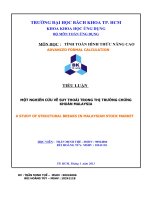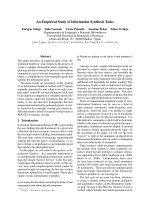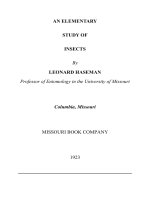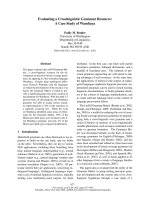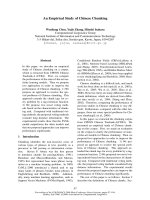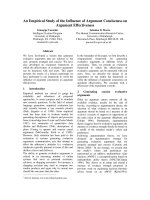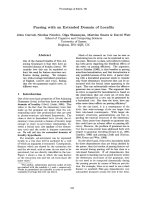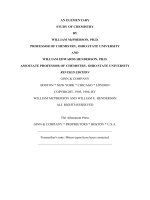AN ELEMENTARY STUDY OF INSECTS pot
Bạn đang xem bản rút gọn của tài liệu. Xem và tải ngay bản đầy đủ của tài liệu tại đây (446.95 KB, 88 trang )
AN ELEMENTARY
STUDY OF
INSECTS
By
LEONARD HASEMAN
Professor of Entomology in the University of Missouri
Columbia, Missouri
MISSOURI BOOK COMPANY
1923
CONTENTS.
INTRODUCTION
CHAPTER I INSECTS:
o (1) What they are.
o (2) Their principal characteristics.
o (3) Their methods of developing.
o (4) The principal orders.
o (5) Their habits.
o (6) Their role in agriculture.
CHAPTER II COLLECTING INSECTS:
o (1) Directions for collecting.
o (2) Pinning and preserving a collection.
o (3) Rearing and observing them while alive.
CHAPTER III THE GRASSHOPPER:
o (1) Brief discussion of the grasshopper.
o (2) Field studies.
o (3) Breeding cage observations.
o (4) Study of specimen.
CHAPTER IV THE HOUSE FLY OR TYPHOID FLY:
o (1) Discussion of the life cycle of the fly, its habits, danger from it and
how it can be stamped out.
o (2) Study of the fly and its work.
CHAPTER V THE MOSQUITO:
o (1) Brief discussion of the life habits and stages of the mosquito.
o (2) Observations and study.
[vi]CHAPTER VI THE CABBAGE MILLER:
o (1) Brief discussion of the caterpillar, the chrysalis, the butterfly, and its
work.
o (2) Observations and study.
o (3) Breeding work.
CHAPTER VII THE APPLE WORM:
o (1) Brief discussion of the different stages of the pest, its work and
remedies for its control.
o (2) Observations and breeding work.
CHAPTER VIII THE TOMATO OR TOBACCO WORM:
o (1) Brief discussion of stages, work and habits.
o (2) Study and observation.
CHAPTER IX THE FIREFLY:
o (1) Brief discussion of the insect.
o (2) Observations and studies.
CHAPTER X THE WHITE GRUB OR JUNE-BUG:
o (1) Discussion of the insect as a pest and its habits and stages.
o (2) Observations and studies.
CHAPTER XI THE COLORADO POTATO BEETLE:
o (1) Brief discussion of the pest.
o (2) Observations and studies.
CHAPTER XII THE LADY-BEETLE:
o (1) Brief discussion of habits and appearance of the lady-beetles, and
their value as friends.
o (2) Observations and studies.
CHAPTER XIII THE DRAGON-FLY:
o (1) Discussion of life and habits of insect.
o (2) Observations and field studies.
[vii]CHAPTER XIV THE SQUASH BUG:
o (1) Discussion of habits, injury and control of pest.
o (2) Observations and field studies.
CHAPTER XV THE PLANT-LOUSE:
o (1) Discussion of habits, injury and control of pest.
o (2) Observations and field studies.
CHAPTER XVI THE HONEY BEE:
o (1) Discussion of the honey bee as to habits in its home and outdoors, its
value to man and the colony as a village.
o (2) Observations and studies.
CHAPTER XVII THE ANT:
o (1) Discussion of ant life and behavior, the colony as a unit, its work and
remarkable instincts.
o (2) Studies and observations.
[ix]
INTRODUCTION
In the preparation of a book of this nature, to be used in the grade schools, we realize
that the one fundamental thing to keep in mind is the economic importance of the
insect, be it good or bad. The child wants to know what is good and what is bad and
how he can make use of the good and how he can get rid of the bad. And yet there is
something more associated with the life, work and development of each tiny insect.
There is a story—a story of growth, not unlike that of the developing child, a story of
courage, strife and ultimate success or failure, which is as interesting and of greater
value to the child than many of the stories of adventure and of historical facts.
Snatches of these stories will appear in the following chapters along with the studies
on insects and their economic importance.
In the development of our grade school system, especially in the rural districts, there is
a growing demand for some practical work along with the regular cultural studies. To
the child in the rural schools, practical knowledge naturally tends toward agriculture.
Many of these boys and girls do not have a chance to pursue studies beyond the
grades[x] and it therefore becomes necessary to introduce some elementary agriculture
into the grades to supply the natural craving of this vast assemblage of children in the
rural schools of our land.
In the search for a study which will give unlimited scope for independent thought and
observation and which will lead the child to understand better the forces of nature that
affect agriculture, nothing is so readily available and attractive to the child as nature
study, an elementary study of the natural sciences. In fact agriculture is primarily a
course in nature study where we study how plants and animals struggle for existence.
There is a period in the life of every child when he is especially susceptible to the "call
of the fields;" when he roams through woods or by shady brooks gathering flowers,
fishing for mud-cats and cleaning out bumble-bees' nests. It is often compared with
the life of the savage and is merely the outward expression of an inward craving for a
closer relation with nature and her creatures. If one can reach a child while at that age
he has a ready listener and an apt pupil. That is the time to guide and instruct the child
along the line of nature study.
The most important questions confronting the average teacher in the grade schools
are: "What material shall I use and how shall I proceed to direct the child along this
line?" First of all use that material which is most readily available, which is most
familiar to the child and which[xi] will attract and hold his attention. There is nothing
so readily available and so generally interesting to both boys and girls as are the
thousands of fluttering, buzzing, hopping and creeping forms of insects. They are
present everywhere, in all seasons and are known to every child of the city or farm.
They are easily observed in the field and can be kept in confinement for study. Many
of them are of the greatest importance to man; a study of them becomes of special
value.
In pursuing a study of nature and her creatures one should go into the woods and
fields as much as possible and study them where they are found. In this way one can
determine how they live together, what they feed on and the various other questions
which the inquisitive mind of a healthy child will ask. When field work is not
possible, gather the insects and keep them alive in jars where they can be fed and
observed. Some forms cannot be kept in confinement and in such cases samples
should be killed and pinned, thereby forming a collection for study.
Most of the forms which are included in the following chapters can be kept in
confinement in glass jars or studies out doors. The studies have been made so general
that in case the particular form mentioned is not available any closely related form can
be used. Each child should make a small collection of living and pinned insects for
study and should be encouraged to observe insects and their[xii] work in the field. The
collections and many of the observations could be made to good advantage during the
summer vacation when the insects are most abundant and active.
Pupils should not be encouraged merely to make observations, but they should be
required to record them as well. Brief descriptions of the appearance and development
of insects, the injury they do, and remedies for the same, will help fix in mind facts
which otherwise might soon be forgotten. Drawings, whenever possible, should also
be required. The pupil who can record observations accurately with drawings will not
soon forget them. The teacher should therefore require each pupil to provide himself
with a note-book for keeping brief, but accurate notes and careful drawings. The
drawings should be made with a hard lead pencil on un-ruled paper, the size of the
note-book, and the pupils should be encouraged to be neat and accurate.
The author wishes to take this opportunity of expressing his deep appreciation for the
many helpful suggestions and other assistance which Mr. R. H. Emberson,
superintendent of Boys and Girls Club Work in Missouri, has given. It was his life-
long devotion to the boys and girls of the grade schools and his keen appreciation of
their needs that lead him first to suggest to the author the importance of preparing this
little book for their use.
University of Missouri.
[xiii]
"The study of entomology is one of the most fascinating of pursuits. It takes its
votaries into the treasure-houses of Nature, and explains some of the wonderful series
of links which form the great chain of creation. It lays open before us another world,
of which we have been hitherto unconscious, and shows us that the tiniest insect, so
small perhaps that the unaided eye can scarcely see it, has its work to do in the world,
and does it."
—
R
E
V.
J.
G
.
W
O
O
D.
[1]
CHAPTER I
INSECTS
"There is a difference between a grub and a butterfly; yet your butterfly was a grub."
—
S
H
A
K
ES
PE
A
R
E.
IN undertaking a study of insects it is well first of all to know something about what
they are, their general nature, appearance, habits and development. The insects
comprise the largest group of animals on the globe. There are about four times as
many different kinds of insects as all other kinds of animals combined. Insects vary
greatly in size. Some are as large as small birds, while others are so small that a
thousand placed in one pile would not equal the size of a pea.
Insects are commonly spoken of as "bugs." This term, however, is properly used only
when referring to the[2] one order of insects which includes the sap and blood-sucking
insects such as the chinch bug, bed-bug, squash bug, and the like. Then too, there are
many so-called "bugs" which are not insects at all. Spiders, thousand-legs, crawfishes
and even earth-worms are often spoken of as bugs.
What They Are
Side view of grasshopper with wings and legs partly removed. Note the division of the
body into head, thorax, composed of prothorax, mesothorax and metathorax, and
abdomen consisting of ring-like segments.
Insects are variously formed, but as a rule the mature ones have three and only three
pairs of legs, one pair of feelers, one pair of large eyes, and one or two pairs of wings.
The body is divided into a head, thorax and abdomen.[3] The head bears the eyes,
feelers and mouth, the thorax bears the legs and wings, and the abdomen is made up of
a number of segments. The presence of wings at once decides whether or not it is an
insect, for, aside from bats and birds, insects alone have true wings. These are the
distinguishing characters of the full grown insect, but, like birds, they hatch from eggs
and while young do not always look like their parents. When young they may take on
various shapes as caterpillars, borers, maggots, grubs, hoppers, and the like. Young
insects are often difficult to distinguish from true worms, centipedes, snails, and such
forms, but after one has collected and reared some of the young and watched them
pass through the different stages and emerge with wings they are much more easily
recognized.
Their Principal Characteristics
Face of grasshopper enlarged showing
parts; ant., antenna; eye, compound eye; oc., ocellus or simple eye; cl., clypeus; lbr.,
labrum or upper lip; mx. p., maxillary palpus; lb. p., labial palpus; lab., labium or
lower lip.
Mouth parts of grasshopper shown in relative
position; lbr., labrum; md., mandibles; hyp., hypopharynx; max., maxillae; lab.,
labium.
Young insects as a rule are soft like caterpillars and maggots, while the old[4] ones
usually have a hard body wall, similar to the beetles and wasps. The wings are usually
thin and transparent though in some cases they are leathery or hard as in case of
beetles or covered with scales as in the butterflies. The three pairs of legs are jointed
and used for running, climbing, jumping, swimming, digging or grasping. The feelers
or antennae are usually threadlike, clubbed, or resemble a feather[5] and extend
forward or sidewise from the head. The large eyes are compound, being made up of
many great small units which, when magnified, resemble honey-comb. In some cases
two or three small bead-like eyes may be present besides the two large eyes. The
mouth parts of insects may be formed for chewing, as in the grasshopper, or for
sucking up liquids, as in the mosquito. The mouth of an[6] insect is built on an
entirely different plan from our own. Chewing insects have an upper and lower lip and
between these there are two pairs of grinding jaws. These jaws are hinged at the side
of the face and when chewing they come together from either side so as to meet in the
middle of the mouth. They therefore work sidewise rather than up and down. The
mouth parts of the sucking insects are drawn out to form a sucking tube or proboscis
as in case of the butterfly or mosquito.
Leg of grasshopper showing segmentation. The
basal segment c, is the coxa, the next t, the trochanter, the large segment f, the femur,
the long slender one ti, the tibia, and the three jointed tarsus ta, with claws at the tip.
The internal organs of insects are similar to those of other animals. The digestive tube
consists of oesophagus, gizzard, or stomach, and intestines. The nervous system is
well developed as shown by the extreme sensitiveness of insects to touch. The brain is
comparatively small except in the bees and ants. The circulatory system consists
simply of a long tube heart, the blood vessels being absent. In this way the internal
organs of the insect are simply[8] bathed in the blood. The system of respiration is
most complicated. The air is taken in through pores usually along the side of the body
and is then carried through fine tracheal tubes to all parts of the body. You cannot
drown an insect by putting its head under water, since it does not breathe through its
mouth. The muscular system is similar to that of other animals which have the
skeleton on the outside.
The internal organs
of the honey bee. Note the strong wing muscles in the thorax. The tube-like heart
begins in the head and extends back through the thorax and follows the curve of the
abdomen. Below the heart is the digestive tube consisting of the slender oesophagus
which extends back to the expanded honey stomach, in which the bee carries the
nectar it collects from flowers, then the curled true stomach, the small intestine and
expanded large intestine. Below this is the nervous system consisting of the brain and
a chain of connected enlargements or ganglia extending back into the abdomen in the
lower part of the body. The respiratory system in part appears just above the honey
stomach, and the black circular or oval spots are cross sections of connecting air tubes,
which run all through the body. Also note the sting with the poison gland and sack
which are pulled out with the sting; also the sucking tube for getting honey from
flowers, and the structures on the legs for gathering and carrying pollen; the pollen
basket is on the back side of the hind leg.
Their Methods of Developing
In most cases the parent insect deposits small eggs which hatch later into the young
insects. In some cases, as with the blow-flies, the maggot may hatch from the egg
while yet in the parent's body, when the active larva is born alive. Whether the egg
hatches before or after it is deposited, the young insect continues to develop in one of
three ways. It may resemble the parent and simply grow as does a kitten, or it may
look somewhat like its parent though smaller and without[9] wings, as the young
grasshopper, or it may bear no resemblance whatever to the parent, as the caterpillar
which feeds and grows and finally spins a cocoon[10] in which it passes to the resting
chrysalis stage and later emerges with wings. The development of insects is therefore
extremely complicated.
The chinch bug showing development
with incomplete metamorphosis; a, egg; b, first nymph; c, second nymph; d, third
nymph; e, fourth nymph; f, adult winged bug; g, chinch bugs extracting sap from corn
plant. To control this pest burn over all winter harboring places and use chemical or
dust barriers following wheat harvest.
The Principal Orders
In order to study a group of animals which includes so many thousand different kinds
it is necessary to divide them into a number of sharply defined divisions or orders. All
animal life is naturally grouped into such divisions and subdivisions. Among the
insects we at once detect seven large, sharply defined divisions or orders, and ten or
more smaller ones. Of these we have first, the two-winged true flies; second, the four-
winged butterflies and moths; third, the hard-backed beetles; fourth, the stinging four-
winged wasps and bees; fifth, the variously formed sucking insects or true bugs, as
chinch bugs and bed-bugs; sixth, the rapid-flying four-winged snake doctors or
dragon-flies and, seventh, the hopping forms, the grasshoppers. Besides these[11] we
have the various smaller orders of water-loving insects, fleas, etc. The[12] seven
groups mentioned above include the majority of our common forms and in the studies
to follow we will include only representatives from these orders.
The Hessian fly showing development
with complete metamorphosis; a, egg; b, larva or maggot; c, flax-seed stage; d, pupa;
e, adult winged fly; f, wheat stubble with flax-seed stages near base taken after
harvest. To control this pest, plow under stubble after harvest; keep down all volunteer
wheat and sow wheat after fly-free date in the fall.
Their Habits
The habits of insects are as varied as their forms and adaptations. Some live in the
water all their life, others spend a part of their life under water, others live the care-
free life of the open air, others enjoy feeding upon and living in the foulest of filth,
others associate themselves with certain definite crops or animals thereby doing
untold injury, while others produce food and other materials which are to be used by
man for his comfort. Every imaginable nook and crook, from the depths of lakes to the
tops of mountains, from the warm, sunny south to the cold frigid north, from the foul
damp swamps to the heart of our desert lands, offers a home for some small
insect.[13]
The most striking habits and developments among insects is found in the more highly
advanced families of bees and ants where definite insect societies are formed,
resembling in many respects human societies and human activities. Among these
villages are established, homes built, battles fought, slaves made, herds kept by
shepherds, and even fields cultivated. In these groups we have the nearest approach to
human intelligence.
Their Role in Agriculture
Some insects may be very destructive to crops, others are beneficial, while the
majority of insects are of no importance to man or agriculture. The various forms of
pests such as the chinch bug, potato beetles, and others do an enormous amount of
damage each year. They destroy hundreds of millions of dollars worth of crops
annually in the United States alone. They devour enough to pay for the entire cost of
running the school system[14] of our country and nearly enough to meet all the
expenses of our government. In view of these facts it is the duty of each and every
farmer, young or old, to acquaint himself with these destructive pests and prepare
himself for combating them. With a knowledge of the methods of controlling these
pests much of this enormous loss can be prevented.
While some insects are extremely injurious, others are very helpful. The products of
the honey bee in the United States alone amount to several million dollars a year, to
say nothing of its value to the farmer in pollinating fruits. The annual output of silk,
all of which is spun by the silkworm, is worth millions of dollars. Many other forms
are of value to man by producing material of commercial value such as lac, shellack,
dyes, medicines, etc. Of all the beneficial insects those which are of greatest value to
man are the parasites and similar forms which help to keep in check many of[15] the
severest pests of the farm. Insects are not all bad fellows by any means. One must
acquaint himself with those which are good and those which are bad before he can
hope to deal with them intelligently.
"And with childlike credulous affectionWe behold those tender wings expand,Emblems
of our own great resurrection,Emblems of the bright and better land."
[16]
CHAPTER II
COLLECTING INSECTS
"Does he who searches Nature's secrets scrupleTo stick a pin into an insect?"
IN the life of every normal human there comes a time when he wishes to make a
collection of some kind. It may be a collection of coins, postage stamps, post-cards,
shells, relics, birds' eggs, pressed flowers or insects. If the child grows up in the
country, the result of this craving is usually three or four cigar boxes of insects or an
almanac or geography stuffed with the most attractive wild flowers of the field. A
collection of this sort may be small and poorly kept and yet it is worth while. In later
life one will[17] search in his mother's closet or attic for the old cigar boxes which
contain the remains of youthful efforts, usually a mass of gaudy wings, fragments of
insect legs and bodies and a few rusty pins. This desire to make a collection is natural
and should be encouraged in the child. It tends to make him observe closely and
creates an interest in things about him, and if properly directed it will add a store of
information which can be gotten in no other way.
Directions for Collecting
A convenient home-made net for catching
insects; note the broom-stick handle, heavy twisted wire and mosquito net bag.
A cyanide jar for killing insects; note the lumps of the deadly
poison potassium cyanide in the bottom covered and sealed by a layer of plaster of
Paris.
Many boys and girls of the rural schools will have little time or inclination to provide
themselves with apparatus for collecting insects. An old straw hat or a limb will serve
their purpose. From their point of view what difference does it make if they tear off
most of the legs and break the wings? They succeed in securing the "bug" and when
pinned in the box it will mean just about as much to them[18] as the most perfect
specimen ever prepared.
This method of catching insects will prove effective where nothing better is available,
but any child can easily make a small insect net by attaching a loop of fairly stiff wire
to a broom handle or other stick and sewing a bag of mosquito netting or other thin
cloth to the wire. By means of such a net one can catch insects more easily and
at[19] the same time there is less danger of tearing such insects as butterflies. Care
must be taken in handling the stinging insects.
The country boy and girl will have little trouble getting hold of insects, but they are
often puzzled when it comes to killing them. It seems cruel[20] to pin up an insect
alive and have it squirm for a day or two and some means of killing them should be
devised. Most of the soft insects, such as flies, butterflies, etc., can be killed by
pressing their body, in the region of the wings, between one's thumb and forefinger.
Such forms as beetles and wasps can be quickly killed by dropping them into coal oil
or a strong soap suds. Any method which can be devised for quickly killing the insect,
and which will not seriously mutilate it, can be used.
A convenient killing bottle can be made by sealing a few small lumps of the deadly
poison, potassium or sodium cyanide, in the bottom of a strong, wide-mouthed bottle,
with plaster of Paris; or a few drops of chloroform or ether on a wad of cotton in a
similar bottle, will also serve as a convenient killing jar.
Pinning and Preserving a Collection
Method of pinning different kinds of
insects.
After the insects, have been caught and killed, they should then be prepared[21] for
the permanent collection. Most insects such as wasps, beetles, flies and grasshoppers
should simply have a pin thrust through their bodies until they are two-thirds the way
up on the pin and then put them away in a box. Such forms as butterflies and moths
make a much better collection if the wings are spread so as to bring out their gaudy
markings. In order to spread butterflies' wings, one needs a spreading board, which
can be made in ten minutes by taking a pine board[22] two feet long, and six inches
wide and on this nail two strips an inch thick, so that there is a crack between them.
The crack should be half an inch wide at one end and a quarter of an inch wide at the
other end, and in the bottom of it press strips of cornstalk pith so as to have something
soft in which to stick the pins. After a pin has been stuck through the body of a dead
butterfly[23] between the wings, it is then pinned in the crack so that the back of the
butterfly is on a level with the strips. Then the wings are drawn forward until they
stand straight out from the body when they are pinned down by means of strips of
paper and left to dry a few days until they become perfectly rigid. In this way a most
beautiful collection can be made very easily,[24] but where time and materials are not
available, simply pin them up like other insects, leaving the wings to hang as they
will. After the specimens are pinned they should be put away in cigar boxes in the
bottom of which is pinned or pasted a layer of cork or corrugated paper similar to that
which comes between glass fruit cans. These make ideal cases for keeping small
collections as the odor of tobacco helps keep pests from getting in to destroy the
collection.
Home-made spreading board for spreading
butterflies and moths.
Cigar box with strip of corrugated
paper in bottom used as case for keeping pinned insects.
Rearing and Observing Them While Alive
While studying an insect it is advisable wherever possible to first study it where it is
found in the field and later bring it home and keep it alive in a jar where it can be fed
and observed and its various habits studied. Cages for breeding insects consist simply
of a few glass fruit cans and jelly glasses with tin or cloth covers. A child can borrow
one or two of these[25] from his mother's fruit cellar. A layer of moist sand or soil
should be put in the bottom of the jar to provide a retreat for those forms which go
into the ground before changing to adults. Before an insect is placed in one of these
breeding cages its food plant should be determined by observations in the field, and
every day or two a fresh supply should be gathered. Most of the forms discussed in the
following chapters can be kept in jars and reared to the adult stage. Rearing insects is
both interesting and instructive. Every child should be given an opportunity to rear a
few forms either during the school year or during the summer vacation.
"I happened one night in my travelsTo stray into Butterfly Vale,Where my wondering
eyes beheld butterfliesWITH WINGS THAT WERE WIDE AS A SAIL.They lived in such
houses of grandeur,[26]Their days were successions of joys,And the very last fad
these butterflies hadWAS MAKING COLLECTIONS OF BOYS.
"There were boys of all sizes and agesPINNED UP ON THEIR WALLS. When I said'Twas
a terrible sight to see boys in that plight,I was answered: 'OH, WELL THEY ARE
DEAD.WE CATCH THEM ALIVE, BUT WE KILL THEM,WITH ETHER—A VERY NICE
WAY:Just look at this fellow—his hair is so yellow,And his eyes such a beautiful gray.
"'Then there is a droll little darky,As black as the clay at our feet;He sets off that
blond that is pinned just beyondIn a way most artistic and neat.[27]And now let me
show you the latest,—A specimen really select,A boy with a head that is carroty-
redAnd a face that is funnily specked.
"'We cannot decide where to place him;Those spots bar him out of each class;We
think him a treasure to study at leisureAnd analyze under a glass.'I seemed to grow
cold as I listenedTo the words that these butterflies spoke;With fear overcome, I was
speechless and dumb,And then with a start,—I awoke!"
[28]
CHAPTER III
THE GRASSHOPPER

